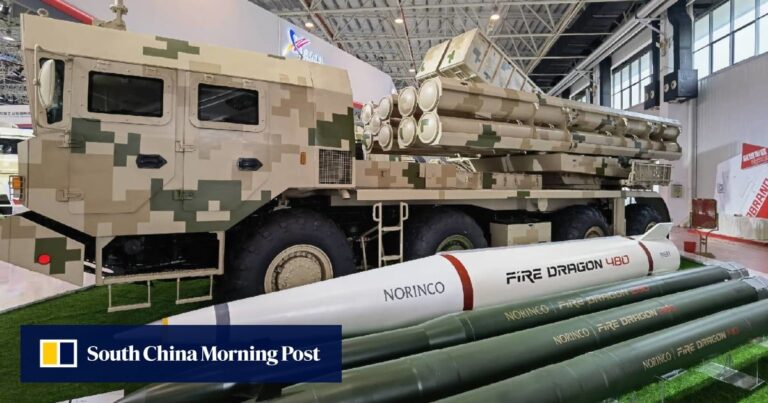The Houthis employ a variety of attack methods, including ballistic missiles, drones and anti-ship cruise missiles.
These attacks took a heavy toll on U.S. Navy sailors, but there is no evidence that they caused any damage to the U.S. Navy.
The long-range rocket “Fire Dragon 480,” manufactured by Arctic Group exclusively for export, is widely recognized as a tactical ballistic missile because it is equipped with precision guidance sensors and can attack moving targets with high accuracy.
“The warhead weighs more than 400 kilograms, significantly exceeding that of conventional anti-ship missiles. Moreover, with an impact velocity exceeding 500 meters (1,640 feet) per second, just two hits of the missiles would be enough to destroy a 10,000-ton cruiser,” Li Jiangjiang, a scientist with the PLA’s Unit 92228, wrote in the paper.
So far, the only arms export documented publicly is a $245 million deal with the United Arab Emirates, which has joined the Saudi-led coalition fighting the Houthis in Yemen.
It’s commonly believed the Fire Dragon 480’s range may be limited to 290 kilometers (180 miles), but Li wrote in his paper that if put into service, its attack range could exceed 500 kilometers.
The rocket can be launched from a fast-moving wheeled platform designed to withstand harsh environments, making it a relatively simple and cost-effective weapon.
But it is widely believed that such attacks would be ineffective against U.S. warships, which are equipped with powerful defense systems.
The USS Dwight D. Eisenhower and its escort fleet, which includes the Ticonderoga-class cruiser used in the PLA simulation and the USS Philippine Sea, are patrolling the Red Sea.
According to Li’s paper, the fighter jet is equipped with two Mk41 vertical launch systems and can fire more than 200 air defense missiles, including the Standard 6 and Sea Sparrow.
In a military war simulation, 12 Fire Dragon 480 rockets were fired at two Ticonderoga-class cruisers.
Before the engagement, the rocket’s pilots had access to low-resolution satellite imagery that allowed them to roughly estimate the location of the U.S. warships. Once in the target area, the rocket activated its onboard sensors to search for targets and fine-tune its trajectory accordingly.
In response, the Ticonderoga-class cruisers launched numerous air defense missiles and activated their Phalanx close-in defense weapons systems.
Of these missiles, the 240 km-range Standard 6 achieved a 71 percent hit rate, while the shorter-range Sea Sparrow missiles achieved a 44 percent hit rate.
When the smoke cleared, one of the cruisers was sunk.
In another scenario, the scientists replaced the warheads of the eight rockets with “swarm warheads,” each carrying six drones.
As these modified rockets approached the U.S. fleet, they slowed down and fired drone warheads. The purpose of these drones was to distract the cruisers’ air defense fire and provide more precise targeting coordinates for a second wave of rocket attacks.
“Once the long-range rockets complete their attack, the swarms will launch direct attacks on the remaining enemy ships,” Li said.
After numerous simulations, scientists estimated that this tactic would mean the survival chances of the two Ticonderoga-class cruisers would be virtually zero.
According to Li, the drones used for swarm attacks could be the Switchblade 600 or similar models, which have an operational radius of more than 40km, are cost-effective and readily available in the international market.
These drones are vulnerable to close-range defense systems like the Phalanx, but when integrated with long-range rockets, they pose a significant threat to warships, Li said.
For the Huolong 480 and its associated drone swarm tactics to reach their full potential, China’s long-range rocket launch system needs to undergo technological upgrades and modifications, according to the study.
To meet the requirements of real combat, the anti-interference capabilities and heterogeneous data links between rockets and drones also need to be strengthened.
Meanwhile, the US is phasing out its Ticonderoga-class cruisers for more modern ships, with the last one due to be retired in 2027.


